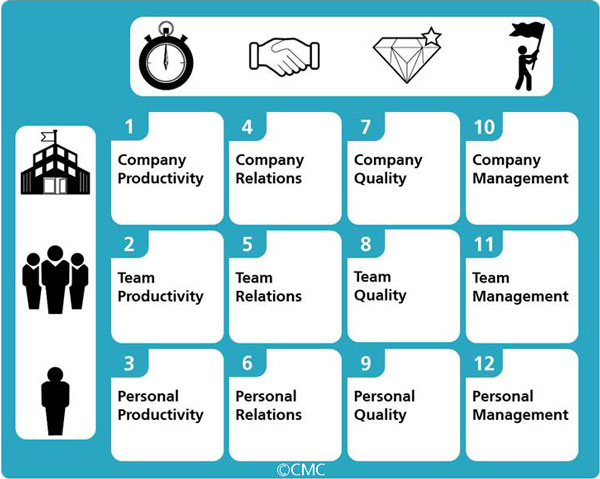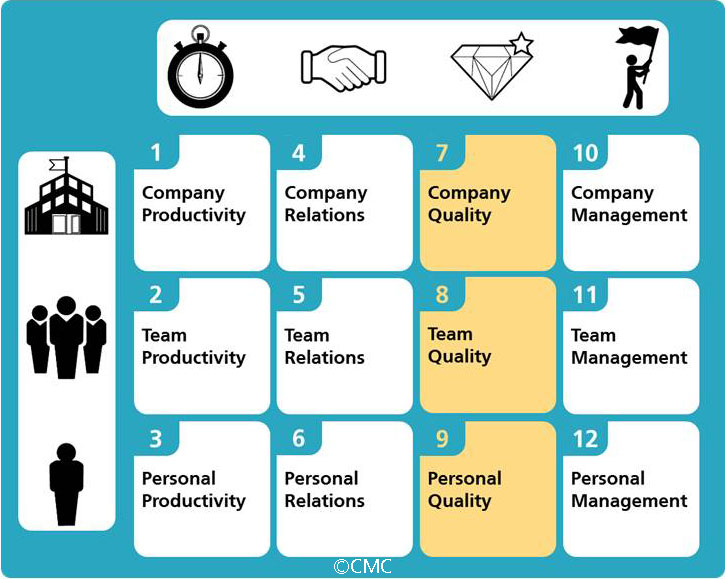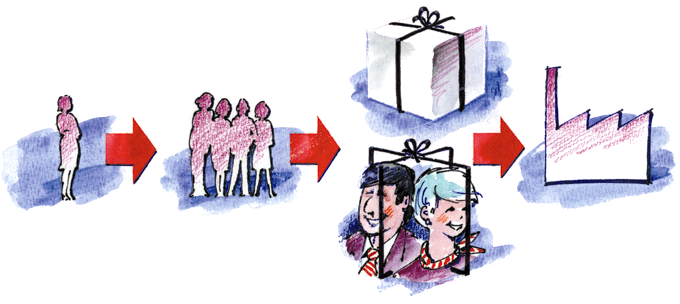An Introduction to Quality Business Excellence (QBE)
Find out more about one of the pillars of our General Business Excellence concept, namely Quality Business Excellence. Quality Business Excellence happens when excellent quality is delivered at all three levels of the organisation: the individual, the team, and the organisation as a whole. Read on for an introduction to the concept of Quality Business Excellence.
In 1990 The British Department of Trade and Industry (DTI) designated Claus Møller one of the world’s 9 “Quality Gurus in Business”, the only European in this distinguished company.
Claus Møller coined the Quality Concepts:
- Personal Quality
- Putting People First
- A Complaint is a Gift
- Internal Customers
- Human Side of Quality
The QBE model is part of Claus Møller’s model General Business Excellence (GBE) – the 12 Windows Model.

QUALITY
is not a management fad but an evergreen concept essential for the survival and growth of any business.
QUALITY is about
- offering emotional and rational value for money to the ones who pay for our existence
- monitoring and meeting or exceeding the demands and expectations from internal and external customers
- building and maintaining an image of the company as an attractive workplace with the best people, products, systems, culture and reputation
- avoiding unnecessary mistakes
- doing what we do correctly
- improving what we do
- developing solutions to meet future needs and wants
Claus Møller’s Quality Management Concept may be seen as an umbrella comprising other quality-related concepts like:
- Total Quality Management (TQM)
- Customer Relationship Management (CRM)
- Branding
- Benchmarking
- Customer Service Recovery
Excellent quality implies high productivity and good relations – and vice versa.
Excellent quality promotes productivity. Excellent productivity promotes quality.
Bad quality impedes productivity. Failure to satisfy customers leads to time and money being spent on non-productive activities like: complaints handling, repair-work, corrections, replacements.
It also leads to lost business!
The Quality Process

The 3 Quality windows in the General Business Excellence model (7, 8 and 9) represent the Quality Behaviour that any company needs to exercise to establish and maintain customer loyalty.
When Quality Behaviour is exercised, monitored and developed at all 3 levels the company has established a QUALITY PROCESS. This process is one of the four vital business processes to be established and maintained in any business.
The Quality Process functions when:
- Everyone is contributing to enhance the brand value of the entire company and its people, products and services
- Everyone strives to meet or exceed the expectations of their internal and external customers to create and maintain customer loyalty.
Claus Møller calls the quality process Customer Loyalty Process.
The challenge for any company is to inspire all employees to contribute to a successful implementation of the Quality Process.
5 Kinds of Quality
Claus Møller’s unique quality concept comprises five different kinds of quality:
- Personal Quality
- Team Quality
- Product Quality
- Service Quality
- Company Quality

Personal quality is the basis of all other kinds of quality
For each of the 5 kinds of quality there are 2 dimensions: Hard and Soft.
HARD SERVICE QUALITY examples:
- Menu and wine lists
- Timetables
- Seat comfort
- Interest rates
- Parking facilities
- Directions for use
- Opening hours
- Insurance policies
- Guarantees
SOFT SERVICE QUALITY examples
- Service provider’s:
– Commitment
– Attitude
– Friendliness
– Flexibility
– Attentiveness - Atmosphere
- Complaint handling
- Keeping promises
2 Quality Standards
Quality standards
For any kind of quality development, two kinds of quality standards need to be defined:
The IP-level
The Ideal level of Performance. This is the quality development goal. That is to say the level to be achieved or the situation desired at a certain time.
The AP-level
The Actual level of Performance. The AP-level is the quality level at any given measuring time.
Main elements of quality development
There may be a great difference between the IP-level and the AP-level. The goal of quality development is to eliminate this difference.
There are three main elements in the quality development process:
- Definition of the IP-level
Determining the ideal/desired level of performance – the quality objective. - Measuring the actual AP – level
Clarifying the actual level of performance – the present standard. - Close the gap
Assessing the difference that has been ascertained between the OP-level and the AP-level and if necessary, to establish and implement a plan for quality development in order to achieve the desired level.
What organisations gain from enhancing company quality
Improved bottom line results through:
- Understanding the quality expectations of the customers
- Adapting products/services to changing market needs and wants
- Inspiring employees to take an active part in The Quality Process
- Establishing and maintaining ”A Complaint is a Gift” culture
- Turning dissatisfied customers into goodwill ambassadors
- Creating ”Emotional Value” for internal and external customers
- Enhancing company reputation and brand value
What teams gain from enhancing Team Quality
Ability to:
- Recognise and understand other people’s demands on and expectations from the team
- Define the quality goals of the team
- Monitor the team quality
- Achieve the agreed team quality goals
- Identify in which areas the team quality needs to be developed
- Assess whether the team culture inspires the members to do their best
- Improve the quality of both individual and team performance
- Inspire and commit everyone to the quality process
- Build and maintain good relations with the team’s stakeholders
- Improve the quality climate in the team and create better team spirit
- Ensure that the name of the team is associated with quality
What individuals gain from enhancing their Personal Quality
- More responsibility and influence
- Better career opportunities
- Better relations with others
- Fewer unnecessary mistakes
- More friends and supporters
- Other people’s trust
- Higher self-esteem
- Better quality of life
Claus Møller is many times awarded management consultant of numerous organizations – IBM, American Express, the European Commission, IKEA, McDonald’s, Shell, Audi/Volkswagen … – and the author of several best-selling books and articles from the areas of management, communications, productivity and human behaviour.

